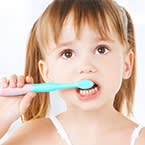What Causes Back Molar Erosion in 12 Year.ds
Tooth decay is now considered the most common childhood disease, affecting one in seven 3 to 5-year-olds, according to the Centers for Disease Control and Prevention. Untreated tooth decay and cavities can be bad news for your child's baby teeth, as well as their future oral health. While toddler tooth decay is a serious issue, it can be prevented by making proactive changes to your child's diet and oral care routine.
Early Signs of Tooth Decay in Toddlers
 Tooth decay in your toddler's smile doesn't have to come as a surprise. While every child is different, here are a few common warning signs that your toddler might be developing tooth decay.
Tooth decay in your toddler's smile doesn't have to come as a surprise. While every child is different, here are a few common warning signs that your toddler might be developing tooth decay.
Visible Signs:
- White Spots: These signal that your child's enamel is starting to break down.
Physical Symptoms:
- Tooth Pain: Your child may cry and/or complain of pain in and around the affected tooth.
- Tooth Sensitivity: Triggered by temperature (think hot or cold drinks) or certain foods (sweets, etc.).
What Causes Tooth Decay in Toddlers?

If you're looking for the main culprit of toddler tooth decay, look no further than your child's diet.
Carbohydrate Rich Foods
Many foods such as milk, fruit juices, candy, and bread, contain carbohydrates which can mix with saliva and naturally occurring mouth bacteria to create acids. These acids erode the structure of the teeth by depleting calcium, creating an unprotected environment on the tooth where cavities can take shape. When possible, let your child enjoy healthy snacks and fill up on water instead of fruit juices to limit their sugar intake.
Bottle Feeding
The condition known as "Baby Bottle Tooth Decay" is caused by putting your baby to bed with a bottle. The sugary formula left in the child's mouth overnight creates the perfect breeding ground for bacteria to grow. Weaning your child off bottles and introducing sippy cups by their first birthday can help mitigate this risk by ensuring drinks are swallowed quickly thus limiting the exposure of sugars in their mouth.
Toddler Tooth Decay Treatment

Even though your child will eventually lose their first set of teeth, toddler tooth decay should never be taken lightly. Cavities in your child's teeth can require extensive dental work in the future, as losing baby teeth early can introduce bacteria to their permanent teeth and continue the cycle of decay. Depending on the severity of the decay, treatments can range from fillings for small cavities to crowns if the damage is more extensive. Visits to the dentist can help identify white spots and cavities early, and prevent them from progressing.
Toddlers' teeth should be brushed starting when the first tooth erupts to ensure their enamel stays strong and healthy. It is recommended that parents brush their kids' teeth until they turn eight years old. You can help fight tooth decay and cavities by using quality products like Oral-B toothbrushes and Crest Kid's Cavity Protection Sparkle Fun toothpaste.
Related articles
 kids-oral-health
kids-oral-health
How to Brush Your Teeth for Kids
Read article
 kids-oral-health
kids-oral-health
Thumb Sucking: Pictures of Effects Thumb Sucking has on Teeth
Read article
 kids-oral-health
kids-oral-health
Can Whitestrips be Used by Children?
Read article
Discover More
 How to Brush Your Teeth for Kids
How to Brush Your Teeth for KidsWhat Causes Back Molar Erosion in 12 Year.ds
Source: https://crest.com/en-us/oral-care-tips/kids/toddler-tooth-decay
0 Response to "What Causes Back Molar Erosion in 12 Year.ds"
Post a Comment